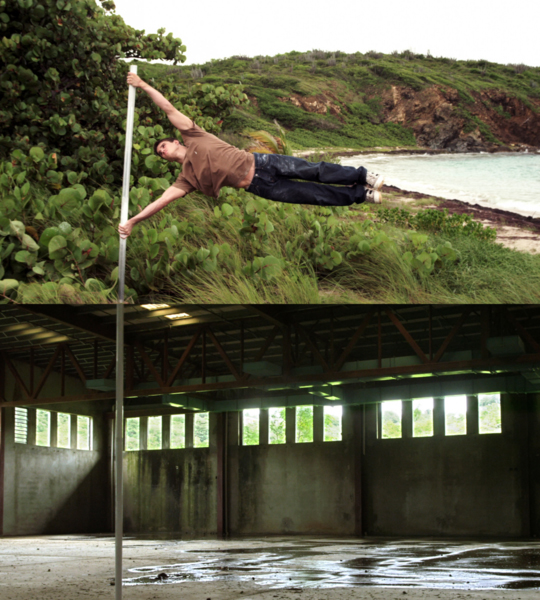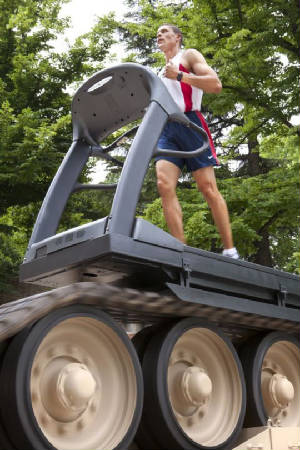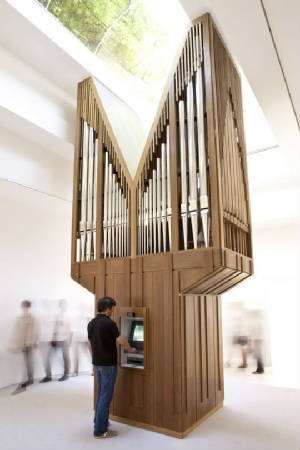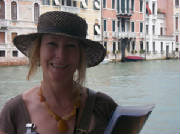
|

|

Allora & Calzadilla, Half Mast\Full Mast (2010). Photo courtesy of the Indianapolis
Museum of Art.
Gloria:
The US at the 54th Venice Biennial
by Meredith Sims
The 54th International
Art Exhibition, La Biennale di Venezia, 2011 is titled ILLUMInations. It is no surprise,
therefore, that
the question of identity, both personal and national, and the
freedom--perceived, permitted or otherwise--of the individual to express or
inhabit that identity are threads that run throughout the exhibition. That the
US national identity is interrogated with such success in the US Pavilion is
thanks in no small part to Lisa
Freiman, senior
curator and chair of the Department of Contemporary Art at the Indianapolis
Museum of Art, and this year’s commissioner for the United States.
Freiman sought
to expand
how the U.S. presented itself at the Biennale, selecting two artists who, while
not
unknown, did not have the big name status of previous representatives and who
were also younger. Selection of the artists Jennifer
Allora and Guillermo Calzadilla and their projects represents
a number of firsts for the U.S.
Pavilion: the first
combined performance and installation, the first representation from an
artistic collaborative, and the first time the artists have been based in the US
Commonwealth, in this case Puerto Rico, rather than mainland USA.
Freiman’s speech at the opening press
conference was refreshing in its direct, jargon
free, and optimistic assessment of what she hoped for the installation and what
it had to say about the US in today’s world. In an earlier interview, she had expressed some
surprise that the project was selected by the State Department, given the
nature of the artists’ political commentary. This choice contrasts with current
political dialogue, which tends to eschew dissension or contradictory opinion
as a necessary process to achieving a worthy and mutually beneficial end. As a meditation
on national identity, the art is stimulating, creative, and posits the US as a
nation capable of critical self-reflection and willing to engage globally.

|
| Allora & Calzadilla, Track and Fied (2011). Photo: Andrew Bordwin. |
Jennifer Allora, originally from Philadelphia, Pennsylvania,
and Guillermo Calzadilla, from Havana, Cuba, are currently based in San Juan, Puerto
Rico and have been working together since 1995. Their art is politically
informed and based in a dialogue between substance, the physicality of the raw
materials of their work, and subtext, the meanings that can be assigned to it
through symbolic, historical
and political references. They like to turn things upside down, sometimes
literally as in the discussion table that becomes a boat in their video Under
Discussion (2005),
and juxtapose disparate objects and experiences, creating an atypical view while
maintaining a cohesive (or adhesive, since Calzadilla referred to the
conceptual “glue”
that holds their objects together) thread of ideas or ideology which one can
use to navigate their installations. This is by no means forced or doctrinaire;
their touch is far defter than that. The underlying seriousness of their work
is lightened by playfulness and the incongruity of the combinations they choose
for many of their installations.
For the US Pavilion, Allora and Calzadilla created six
site-responsive works and entitled the collective installation Gloria, a
Spanish derivative of the word glory. This could refer to the honor and
distinction of the Olympic athletes who participate, or equally, the glory of
US military might. It also hints at the
recurring theme of duality: female/ male (Gloria versus Uncle Sam), strength
versus flexibility, nation versus individual, among others. In particular it is
reiterated by differences between the male and female athletes who perform
respectively in Body in Flight (American) and Body in Flight (Delta). In these performances,
the sheer strength of the male gymnasts impresses and captivates, overpowering
the rhythmic balance of the female routine. A metaphor, perhaps, for how
strength and power generally are perceived as being of more value than
flexibility and grace.
As a commentary on the US as a
global identity, the project extends world-wide. All of the materials Allora
and Calzadilla use come from different places: a military tank from England, an
organ handcrafted in Germany, a bronze statue and airline seats fabricated in
California, a tanning bed from Indianapolis, and an ATM from Milan. It also extends to artistic
collaborative: An engineer was required to help develop the computer program
that runs the ATM, and a choreographer developed the gymnastic routines as
performance with some assistance from the athletes themselves. Three of the
works include performances from U.S. Track and Field members or USA Gymnastics,
including Olympian Dan O’Brien, the 1996 Olympic gold medalist in the decathlon,
2007 U.S. all-around champion David Durante, and 2005 World all-around champion
and 2008 Olympic team silver-medalist Chellsie Memmel.

|
| Allora & Calzadilla, Algorithm(2011). Photo: Andrew Bordwin. |
One thing the US is not usually accused of is subtlety, and
the installation is kicked off by the in-your-face Track and Field, a 52
ton military tank turned upside
down and transformed into a running machine, situated in front of the pavilion.
The rotating tread is mirrored by the smaller rotation of a treadmill fitted to
the top (formerly the bottom) of the tank where, periodically, an athlete
climbs to begin their workout. This piece also
provides a metaphor for the pervasiveness of US culture, as the sound of the
tank’s treads turning reverberates around nearby pavilions, not particularly
unpleasant but a little puzzling, as the ear seeks out the source of noise.
On
entering the US pavilion one is greeted first by the work Armed Freedom
Lying on a Sunbed. This
is an altered replica of the Statue of Freedom, 1863, also known as Armed
Freedom,
a bronze status designed by Thomas Crawford that crowns the dome of the US
Capitol in Washington, D.C. The statue, which depicts a female
figure representing Liberty, is lying down, resting in a Solaris
sun bed. Is this a statement on the current state of freedom or simply a comment
on the artificial
patina of freedom, the shiny glow beneath which a messier reality exists?
In adjoining rooms, balanced to
the left and right, one finds the installations of Body in Flight
(Delta)
and Body in Flight (American) featuring carved wooden replicas
of current
business-class seating on those airlines.
When seen vacant, what most immediately occurs is the memory of September
11. The form and indentations from those who were there before are obvious and
invoke a sense of vacancy, a poignant missing that once again reminds us of
those lost during those attacks.

|
| Allora & Calzadilla, Body in Flight (American) (2011). Photo: Andrew Bordwin. |
In performance, the seats take on a different
complexion as alternatives to the familiar pommel horse and balance beams used
by gymnasts. The choreography for each performance is precise and well beyond
the usual three-minute gymnastic routine, stretching the athletes who must also
replicate each performance exactly. The gymnasts wear their US red, white and
blue costumes, which threads into their routine the question of national
identity and the perception of the US globally.
In the room immediately behind the masculine performance of Body in Flight (American) is the installation
Half Mast\Full Mast (2010), a twenty-one minute video which consists of
dual screens, one on top of the other. Through the projections of scenes from the
island of Vieques, Puerto Rico, a flagpole maintains its presence in the center
of each screen, connecting them vertically and creating a feeling of permanence
and continuity. At regular intervals, on either the lower or the upper screen,
a participant enters and walks towards the flagpole, where they hoist
themselves, using raw physical power to hold their body horizontally, a human
flag. On first approach,
this is an engaging view of raw personal power. On further review, the grey
skies take on a darker hue, reflecting the heaviness of the island’s earlier
military history: formerly used as a
United States Navy bombing range
and testing ground, international
controversy and decades of protests eventually led to the Navy's departure in 2003. The scenes in
the video depict places symbolic to the struggle to restore the island to its
inhabitants and to a sustainable environmental and developmental footing. It is only with the closing of the
US bases that the island once again belongs to its occupants. In the artists’
video Returning a Sound (2004), a figure navigates the entire island by moped,
making the point
that it is now possible to do so. Much of the island has since been
designated a National Wildlife Refuge.
Behind
Body in Flight (Delta) is the room containing Algorithm. The use of sound has
been a recurring theme in Allora and Calzidilla’s work and it is integral to Algorithm, a
towering organ sculpture with an embedded and fully functional ATM machine.
Each transaction creates its own unique musical dialogue from air pushed
through the organ pipes. The
sounds and the tower soaring to the sky-lit ceiling engage the viewer and distract
to a degree from the commercial nature of the embedded ATM, leaving sufficient
room to consider which is dominant: the power of money and global commerce, or
the ability of each individual to determine and choose their own destiny? The
playing of the ATM keyboard is after all a choice and the expression unique for
each composition.

|
| Allora & Calzadilla, Body in Flight (American) (2011). Photo: Andrew Bordwin. |

|

|

|


